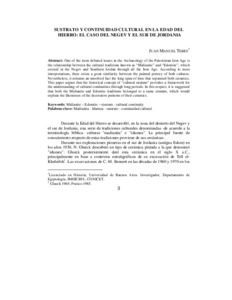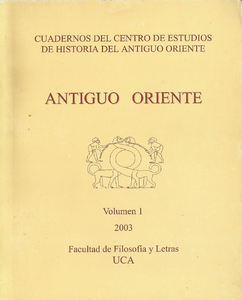Por favor, use este identificador para citar o enlazar este ítem:
https://repositorio.uca.edu.ar/handle/123456789/11777| Título: | Sustrato y continuidad cultural en la edad del hierro : el caso del Negev y el sur de Jordania Substrate and cultural continuity in the age of Iron : the case of the Negev and southern Jordan |
Autor: | Tebes, Juan Manuel | Palabras clave: | INTERCAMBIO; HISTORIA CULTURAL; EDAD DE HIERRO; ARTE ANTIGUO; CERAMICA | Fecha de publicación: | 2003 | Editorial: | Universidad Católica Argentina. Facultad de Ciencias Sociales. Departamento de Historia. Centro de Estudios de Historia del Antiguo Oriente | Cita: | Tebes, J. M. Sustrato y continuidad cultural en la edad del hierro : el caso del Negev y el sur de Jordania [en línea]. Antiguo Oriente: Cuadernos del Centro de Estudios de Historia del Antiguo Oriente. 2003, 1. Disponible en: https://repositorio.uca.edu.ar/handle/123456789/11777 | Resumen: | Abstract: One of the most debated issues in the Archaeology of the Palestinian Iron Age is
the relationship between the cultural traditions known as “Midianite” and “Edomite”, which
existed in the Negev and Southern Jordan through all the Iron Age. According to most
interpretations, there exists a great similarity between the painted pottery of both cultures.
Nevertheless, it remains an unsolved fact the long span of time that separated both ceramics.
This paper argues that the historical concept of “cultural stratum” provides a framework for
the understanding of cultural continuities through long periods. In this respect, it is suggested
that both the Midianite and Edomite traditions belonged to a same stratum, which would
explain the likenesses of the decorative patterns of their ceramics. Resumen: Durante la Edad del Hierro se desarrolló, en la zona del desierto del Negev y el sur de Jordania, una serie de tradiciones culturales denominadas -de acuerdo a la terminología bíblica- culturas "madianita" e "idumea". La principal fuente de conocimiento respecto de estas tradiciones proviene de sus cerámicas. Durante sus exploraciones pioneras en el sur de Jordania (antigua Edom) en los años 1930, N. Glueck descubrió un tipo de cerámica pintada a la que denominó "idumea". Glueck posteriormente dató esta cerámica en el siglo X a.C., principalmente en base a contextos estratigráficos de su excavación de Tell el- Kheleifeh1. Las excavaciones de C.-M. Bennett en las décadas de 1960 y 1970 en los principales sitios de Edom (Buseirah, Tawilan, Umm el-Biyara), produjeron más vasijas de este tipo. Según el consenso general actual, los sitios idumeos fueron ocupados no antes del 700 a.C. |
Cobertura Espacial: | Israel | URI: | https://repositorio.uca.edu.ar/handle/123456789/11777 | ISSN: | 1667-9202 | Disciplina: | HISTORIA | Derechos: | Acceso abierto | Fuente: | Antiguo Oriente: Cuadernos del Centro de Estudios de Historia del Antiguo Oriente 2003, 1 |
| Appears in Collections: | AO - 2003 nro.1 |
Files in This Item:
| File | Description | Size | Format | |
|---|---|---|---|---|
| sustrato-continuidad-cultural.pdf | 188,07 kB | Adobe PDF |  View/Open | |
| antiguo-oriente-vol. 1.jpg | 1,19 MB | JPEG |  View/Open |
Visualizaciones de página(s)
107
comprobado en 30-abr-2024
Descarga(s)
216
comprobado en 30-abr-2024
Google ScholarTM
Ver en Google Scholar
Este ítem está sujeto a una Licencia Creative Commons

